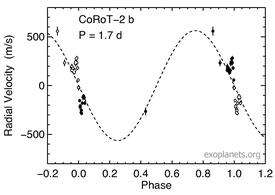CoRoT-2b
| Exoplanet | List of exoplanets | |
|---|---|---|
 | ||
| Parent star | ||
| Star | COROT-2 | |
| Constellation | Aquila | |
| Right ascension | (α) | 19h 27m 06.5s[1] |
| Declination | (δ) | +1° 23′ 01.5″ |
| Distance | 930 ly (290 pc) | |
| Spectral type | G7V[2] | |
| Orbital elements | ||
| Semi-major axis | (a) | 0.0281 ± 0.0005[1][3] AU |
| Eccentricity | (e) | 0 (assumed)[1] |
| Orbital period | (P) | 1.7429964 ± 0.0000017[1] d |
| Inclination | (i) | 87.84 ± 0.10[1]° |
| Time of transit | (Tt) | 2454237.53562 ± 0.00014[1] JD |
| Physical characteristics | ||
| Mass | (m) | 3.31 ± 0.16[1] MJ |
| Radius | (r) | 1.429 ± 0.047[1] RJ |
| Density | (ρ) | 1310 ± 40[1] kg m−3 |
| Geometric Albedo | (Ag) | <0.12 |
| Surface gravity | (g) | 38.2[4] m/s² |
| Temperature | (T) | 1537 ± 35[1] |
| Discovery information | ||
| Discovery date | 2007-12-??, announced 2007-12-20 | |
| Discoverer(s) | Corot mission | |
| Discovery method | Transit method | |
| Other detection methods | Radial velocity, Reflection/emission modulations | |
| Discovery site | Earth's orbit | |
| Discovery status | Confirmed | |
| Other designations | ||
| CoRoT-Exo-2b | ||
| Database references | ||
| Extrasolar Planets Encyclopaedia | data | |
| SIMBAD | data | |
| Exoplanet Archive | data | |
| Open Exoplanet Catalogue | data | |
COROT-2b (formerly known as COROT-Exo-2b[5]) is the second extrasolar planet to be detected by the French-led COROT mission, and orbits the star COROT-2 at a distance of 930 light years from Earth towards the constellation Aquila. Its discovery was announced on 20 December 2007.[6] After its discovery via the transit method, its mass was confirmed via the radial velocity method.
Characteristics

The planet is a large hot Jupiter, about 1.43 times the radius of Jupiter and approximately 3.3 times as massive. Its huge size is due to the intense heating from its parent star, which causes the outer layers of its atmosphere to bloat. The extremely large radius of the planet indicates that COROT-2b is very hot, estimated to be around 1500 K, even hotter than would be expected given its location close to its parent star. This fact may be a sign of tidal heating due to interactions with another planet.[7] At Jupiter-like distances its radius would roughly be the same as Jupiter.[8] The complete phase curve of this planet has been observed.[9]
COROT-2b orbits its star approximately once every 1.7 days, and orbits the star in a prograde direction close to the star's equator.[2] Its parent star is a G-type star, a bit cooler than the Sun but more active. It is located about 800 light-years from Earth.
It takes 125 minutes to transit its star.[10]
As of August 2008, the COROT-2b spin-orbit angle (that is, the angle between the equator of the star and the plane of the planet orbit) was calculated by Bouchy et al. by means of the Rossiter–McLaughlin effect[11] with a value of +7.2 ± 4.5 degrees.[2]
References
- 1 2 3 4 5 6 7 8 9 10 Alonso et al. (2008). "Transiting exoplanets from the CoRoT space mission. II. CoRoT-Exo-2b: a transiting planet around an active G star". Astronomy and Astrophysics. 482 (3): L21–L24. arXiv:0803.3207
 . Bibcode:2008A&A...482L..21A. doi:10.1051/0004-6361:200809431.
. Bibcode:2008A&A...482L..21A. doi:10.1051/0004-6361:200809431. - 1 2 3 Bouchy, F.; Queloz, D.; Deleuil, M.; Loeillet, B.; Hatzes, A. P.; Aigrain, S.; Alonso, R.; Auvergne, M.; Baglin, A.; Barge, P.; Benz, W.; Bordé, P.; Deeg, H. J.; De La Reza, R.; Dvorak, R.; Erikson, A.; Fridlund, M.; Gondoin, P.; Guillot, T.; Hébrard, G.; Jorda, L.; Lammer, H.; Léger, A.; Llebaria, A.; Magain, P.; Mayor, M.; Moutou, C.; Ollivier, M.; Pätzold, M.; et al. (2008). "Transiting exoplanets from the CoRoT space mission". Astronomy and Astrophysics. 482 (3): L25. arXiv:0803.3209
 . Bibcode:2008A&A...482L..25B. doi:10.1051/0004-6361:200809433.
. Bibcode:2008A&A...482L..25B. doi:10.1051/0004-6361:200809433. - ↑ The paper gives the semimajor axis as 6.70 ± 0.03 times the radius of the star, which is estimated at 0.902 ± 0.018 solar radii.
- ↑ Calculated using Newtonian gravity:
- ↑ Schneider, J. (10 March 2009). "Change in CoRoT planets names". Exoplanets (Mailing list). Retrieved 2009-03-19.
- ↑ "COROT surprises a year after launch". Retrieved 2007-12-21.
- ↑ "CoRoT-exo-2 c?". Retrieved 2007-12-21.
- ↑ Gibor Basri; Brown (20 August 2006). "Planetesimals to Brown Dwarfs: What is a Planet?". Annu. Rev. Earth Planet. Sci. 34: 193–216. arXiv:astro-ph/0608417
 . Bibcode:2006AREPS..34..193B. doi:10.1146/annurev.earth.34.031405.125058.
. Bibcode:2006AREPS..34..193B. doi:10.1146/annurev.earth.34.031405.125058. - ↑ http://adsabs.harvard.edu/abs/2011sptz.prop80044C
- ↑ "Predicted Transit Epochs: CoRoTExo2 b". TransitSearch (Oklo Corporation). Retrieved 2009-07-15. External link in
|publisher=(help) - ↑ Joshua N. Winn (2008). "Measuring accurate transit parameters". Proceedings of the International Astronomical Union. 4: 99. arXiv:0807.4929
 . doi:10.1017/S174392130802629X.
. doi:10.1017/S174392130802629X.
External links
![]() Media related to COROT-2b at Wikimedia Commons
Media related to COROT-2b at Wikimedia Commons
Coordinates: ![]() 19h 27m 06.5s, +01° 23′ 01.5″
19h 27m 06.5s, +01° 23′ 01.5″